

Black History in America. 1901 Louis Armstrong is born: The Jazz Original "Through his clear, warm sound, unbelievable sense of swing, perfect grasp of harmony, and supremely intelligent and melodic improvisations, he taught us all to play jazz.

" —Wynton Marsalis. Library System - Howard University. A Centennial Tribute to Langston Hughes Painting by Artist Winold Reiss, National Portrait Gallery ~Dream Deferred~ What happens to a dream deferred?

Does it dry up like a raisin in the sun? Or fester like a sore-- and then run? Langston Hughes Biography. “An artist must be free to choose what he does, certainly, but he must also never be afraid to do what he might choose.”
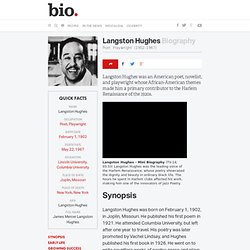
“I have discovered in life that there are ways of getting almost anywhere you want to go, if you really want to go.” “We Negro writers, just by being black, have been on the blacklist all our lives. Censorship for us begins at the color line.” “Humor is laughing at what you haven't got when you ought to have it.” “Let the rain kiss you. Harlem Renaissance. During the early 20th century, African-American poets, musicians, actors, artists and intellectuals moved to Harlem in New York City and brought new ideas that shifted the culture forever.
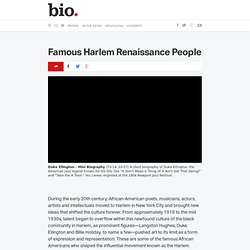
During the early 20th century, African-American poets, musicians, actors, artists and intellectuals moved to Harlem in New York City and brought new ideas that shifted the culture forever. JAZZ A Film By Ken Burns: Jazz in Time - Roaring Twenties. Roaring Twenties excerpted from Jazz: A History of America's Music The decade following World War I would one day be caricatured as "the Roaring Twenties," and it was a time of unprecedented prosperity — the nation's total wealth nearly doubled between 1920 and 1929, manufactures rose by 60 percent, for the first time most people lived in urban areas — and in homes lit by electricity.
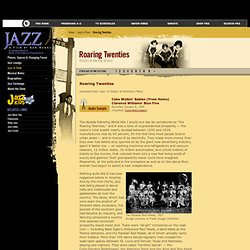
They made more money than they ever had before and, spurred on by the giant new advertising industry, spent it faster, too — on washing machines and refrigerators and vacuum cleaners, 12 million radios, 30 million automobiles, and untold millions of tickets to the movies, that ushered them into a new fast-living world of luxury and glamour their grandparents never could have imagined. Meanwhile, at the polls and in the workplace as well as on the dance floor, women had begun to assert a new independence. Nothing quite like it had ever happened before in America. There was nothing new in these attitudes. Jazz Standards Songs and Instrumentals (Ain't Misbehavin') Harlem Renaissance Music.
89.01.05: The Impact of the Music of the Harlem Renaissance on Society. The community of Harlem is one which is rich in history and culture.
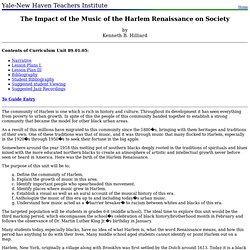
Throughout its development it has seen everything from poverty to urban growth. In spite of this the people of this community banded together to establish a strong community that became the model for other black urban areas. As a result of this millions have migrated to this community since the 1880s, bringing with them heritages and traditions of their own. The Harlem Renaissance and American Music. Musicians - The Harlem Renaissance. Musicians Billie Holiday(Lady Day) (1915-1959) During the 1950’s Billie Holiday rose as a social phenomenon.
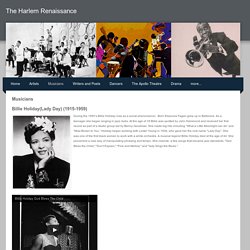
Born Eleanora Fagan grew up in Baltimore. As a teenager she began singing in jazz clubs. At the age of 18 Billie was spotted by John Hammond and received her first record as part of a studio group led by Benny Goodman. Chick Webb (1905-1939) Born William Henry Webb, know as Chick Webb was and American jazz ad swing music drummer. Harlem Project Langston Hughes. Hughes is often penned as the father of the Harlem Renaissance.
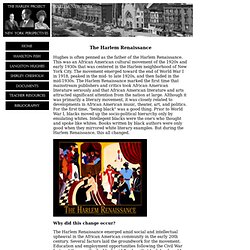
This was an African American cultural movement of the 1920s and early 1930s that was centered in the Harlem neighborhood of New York City. The movement emerged toward the end of World War I in 1918, peaked in the mid- to late 1920s, and then faded in the mid-1930s. The Harlem Renaissance marked the first time that mainstream publishers and critics took African American literature seriously and that African American literature and arts attracted significant attention from the nation at large.
Although it was primarily a literary movement, it was closely related to developments in African American music, theater, art, and politics. For the first time, "being black" was a good thing. Why did this change occur? PAL: Harlem Renaissance: A Brief Introduction. Outside Link: | Schomburg Exhibition, Harlem 1900-1940 | Page Links: | Important Features | Personalities | An Assessment | A Chronology of Important Events | Novels of the Harlem Renaissance | Research and Study Topics | MLA Style Citation of this Web Page | Site Links: | Chap. 9: Index | Chap. 9: Selected Bibliography | Alphabetical List | Table Of Contents | Home Page | | Top | Important Features 1.
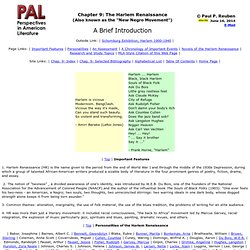
The Harlem Renaissance. The Savoy Ballroom in Harlem in 1926 was The Place and Lindy Hop was The Dance!
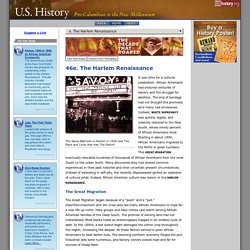
It was time for a cultural celebration. The Ideologies of African American Literature: From the Harlem Renaissance ... - Robert E. Washington. A Brief Guide to the Harlem Renaissance. In the decades immediately following World War I, huge numbers of African Americans migrated to the industrial North from the economically depressed and agrarian South. In cities such as Chicago; Washington, D.C.; and New York City, the recently migrated sought and found (to some degree) new opportunities, both economic and artistic. The Rise and Fall of Jim Crow . Jim Crow Stories . The Harlem Renaissance. Harlem Renaissance - Black History. The northern Manhattan neighborhood of Harlem was meant to be an upper-class white neighborhood in the 1880s, but rapid overdevelopment led to empty buildings and desperate landlords seeking to fill them.
In the early 1900s, a few middle-class black families from another neighborhood known as Black Bohemia moved to Harlem, and other black families followed. Some white residents initially fought to keep African Americans out of the area, but failing that many whites eventually fled. Outside factors led to a population boom: From 1910 to 1920, African American populations migrated in large numbers from the South to the North, with prominent figures like W.E.B.
Du Bois leading what became known as the Great Migration. Harlem Renaissance (American literature and art) Stormy Weather 1943.